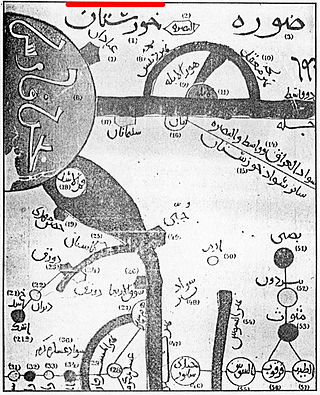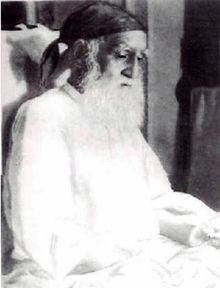Shrine

His shrine is situated in Khushab Sharif. It has a mosque with it. [8] [10] [3] [11]
Shah Maroof Khushabi | |
|---|---|
| Born | PakPattan |
| Burial place | Khushab |
| Era | 16th Century |
| Predecessor | Shah Mubarak Haqani |
| Successor | Shah Sulaimān Nūri |
| Father | Sheikh Adam |
| Family | From Family of Fareed uddin Ganj Shakar and Ameer ul Momineen Umar Farooq |
Makhdoom Shah Maroof Khushabi [1] [2] [3] was a sufi, saint and preacher of Islamic of Qadiriyya Silsila. He was the successor of Shah Mubarak Haqani [1] [2] (From Uch Sharif). He was a member of the Chishti Order (due to his father Shiekh Adam) and the Qadiriyya order (due to his spiritual leader Shah Mubarak Haqani).
Shah Maroof Khushabi was born in Pakpattan. His father's name was Shiekh Adam. [1] He got his early education from his father Sheikh Adam.
His family lineage goes to Fariduddin Ganjshakar, Ibrahim ibn Adham and Ameer ul Momineen Umar e Farooq. [2]
In 908 Hijri, Shah Mubarak Haqani came to the forest near Khushab. People heard that a friend of Allah has come to the jungle but they did not dare to go there. Shah Maroof also listened and went to his place. Shah Mubarak was in meditation when Shah Maroof arrived. Shah Mubarak warned him not to come but he approached nevertheless. He became unconscious when he came near to him. After 3 days he regained consciousness again. Shah Mubrakak was impressed by him. So he made him his successor, linking him to Silsila e Qadiria. [4] [2]
He got his spiritual teachings from Shah Mubarak Haqani.
He belonged to Silsila e Qadriyya as below:
His successor in Silsila e Qadiriyya and "Sajaada e Nasheen" was Sakhi Shah Suleman Noori Hazoori from Purana Bhalwal. [6]
The following are his successors:
He travelled many places on the verdict of his "Murshid" and blessed everyone he met. He always remained in remembrance of Allah. At each place, the people gathered around him. He did not wanted to show himself but "it is impossible to hide a sun" so people always found him. It is said that many patients became fit on his one eyesight. Many non-Muslims became Muslim on his hand. He brought the message of Allah to Khushab [7]
Shah Maroof Qadri Chisti Khushabi died on 10th Muharram 1579 in the era of Mughal king Jalal-uddin Mohammad Akbar. [8] His feast is held every year on 9th and 10th Muharram. [9]

His shrine is situated in Khushab Sharif. It has a mosque with it. [8] [10] [3] [11]

Sultan Bahu, was a 17th-century Punjabi Muslim Sufi mystic, poet, scholar and historian. He was active in the Punjab region during the reigns of Mughal emperors Shah Jahan and Aurangzeb.

Although Herodotus and Xenophon referred to the entire region as Susiana, the name Khuzestan is what has been referred to the southwesternmost province of Persia (Iran) from antiquity.

The Qadiriyya or the Qadiri order is a Sufi mystic order (tariqa) founded by Sheikh Abdul Qadir Gilani, who was a Hanbali scholar from Gilan, Iran. The order relies strongly upon adherence to the fundamentals of Sunni Islamic law.

Safdarabad, is city in Sheikhupura District in the Punjab province of Pakistan. The city of Safdar Abad is the capital of Safdarabad Tehsil. Its Postal code or ZIP code is 39540. Its urban area is approximately 600 acres. Until 2005 it was a tehsil of Sheikhupura District, but in that year Sheikhpura was bifurcated and the district of Nankana Sahib was created. - with Safdarabad as one of its tehsils. Now at present, once again Safdarabad has been rejoined with Sheikhupura as a Tehsil of it. The city of Safdarabad lies 95 km from Lahore the provincial capital of Punjab. The area has a population of more than 40,000 the majority of whom are Muslims. There are many engineering and medical students from Safdarabad admitted to different universities across Pakistan, including UET, Lahore.

Abdul Qadir Gilani was a Hanbali scholar, preacher, and Sufi leader who was the eponym of the Qadiriyya, one of the oldest Sufi orders.
Mubarak Ali Shah Gillani was a Pakistani Sufi religious leader in the United States. A member of the Qadiriyya tariqa, he was the founder of The Muslims of America (MOA) and also founded the International Qur'anic Open University.

Pir Meher Ali Shah, was a Punjabi Muslim Sufi scholar and mystic poet from Punjab, British India. Belonging to the Chishti order, he is known as a Hanafi scholar who led the anti-Ahmadiyya movement. He wrote several books, most notably Saif e Chishtiyai, a polemical work criticizing the Ahmadiyya movement of Mirza Ghulam Ahmad.

Syed Muhammad Ibrahim bin Syed Fatehullah Kirmani 1513-1575C.E., more popularly known as Shaikh Daud Bandagi Kirmani was a 16th-century saint of the Qadiri order.

Safdarabad, is an administrative subdivision (Tehsil) of Sheikhupura District in the Punjab province of Pakistan. The city of Safdar Abad is the headquarters of the tehsil, until 2005 it was a tehsil of Sheikhupura District, but in that year Sheikhpura was bifurcated and the district of Nankana Sahib was created. - with Safdarabad as one of its tehsils. Now at present, once again Safdarabad has been rejoined with Sheikhupura as a Tehsil. The city of Safdarabad lies 95 km from Lahore the provincial capital of Punjab. The tehsil has a population of more than 270,000 the majority of whom are Muslims.
Qaderi is an Arabic/Islamic surname. It is associated with the Sufi saint Abdul Qadir Gilani or the Qadiriyya order founded by him.

Shah Niyaz Ahmad (1742-1834) was a Sufi, poet and author from India.

Sheikh Noor Ul Mashaikh Sayyid Ahmed Muhiuddin Jeelani NooriShah Arabic:, known more commonly as NooriShah Jeelani, was a renowned 20th-century muslim, sufi, wali, mystic, orator, faqeeh, theologian, mujaddid and highly acclaimed Islamic scholar of the Qadri, Chisti order from the Indian sub continent. He was the 21st grand son of the famous Sufi saint Ghous-e-Azam Sheikh Mohiyudheen Abdul Qadir Jilani of Baghdad. He was also widely known by his title Noor-ul-Mashaikh. He was the Eponymous founder of the Silsila-e-Nooriya tariqa which is a sub-branch of Qadiriyya and Chistiyya in India.

Shah Inayatullah, popularly known as Sufi Shah Inayat Shaheed, Shah Shaheed or Shah Inayat of Jhok, was a 17th-century Sindhi Sufi saint and revolutionary from Jhok. He was the first socialist and agricultural reformist of Sindh.

The Shrine of Meher Ali Shah is a 20th-century Sufi shrine that serves as the tomb of the Peer Meher Ali Shah, an early 20th-century Sufi scholar of the Chisti order, who was also a leader of the anti-Ahmadiya movement. The shrine is located within the Islamabad Capital Territory, in the village of Golra Sharif.

Abdul Rehman Jilani Dehlvi was a Sufi saint of the Qadri Order in the Indian Subcontinent. His predecessors include Abdul Qadir Jilani, who initiated the lineage (silsila) of the Qadri order. He helped to establish the order in Delhi.

ʿAbd al-Razzāq b. ʿAbd al-Qādir al-Jīlānī, also known as Abū Bakr al-Jīlī or ʿAbd al-Razzāq al-Jīlānī for short, or reverentially as Shaykh ʿAbd al-Razzāq al-Jīlānī by Sunni Muslims, was a Persian Sunni Muslim Hanbali theologian, jurist, traditionalist and Sufi mystic based in Baghdad. He received his initial training in the traditional Islamic sciences from his father, Abdul-Qadir Gilani, the founder of the Qadiriyya order of Sunni mysticism, prior to setting out "on his own to attend the lectures of other prominent Hanbali scholars" in his region. He is sometimes given the Arabic honorary epithet Tāj al-Dīn in Sunni tradition, due to his reputation as a mystic of the Hanbali school.

Syed Ghulam Moinuddin Gilani commonly known as Baray Lala jee born on Saturday, 22 May 1920 at Golra Sharif, of district Rawalpindi was the Sajjada Nashin of Shrine Golra Sharif. He was the grandson of Pir Meher Ali Shah. He was the son of Syed Ghulam Mohiyyuddin Gilani and father of Pakistani scholar Naseer-uddin-Naseer. He is also the elder brother of Syed Shah Abdul Haq Gilani.

Shah Suleman Noori Hazoori was a 16th-century scholar, saint and Sufi of Qadiriyya silsila (lineage) in the subcontinent that became modern day Pakistan. His spiritual teacher (murshid) was Shah Maroof Khushabi.